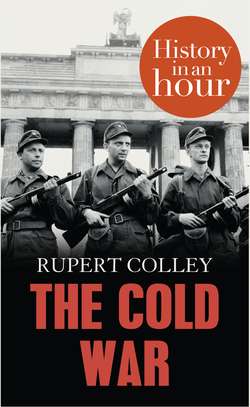Читать книгу The Cold War: History in an Hour - Rupert Colley - Страница 12
ОглавлениеThe Korean War: Hot War
The Korean War: Korean children in front of a US tank
The first major conflict – the first ‘hot war’ of the Cold War – took place in Korea between 1950 and 1953. Ruled by Japan since 1910, Korea rejoiced in Japan’s defeat, and following the end of the Second World War, was split between Soviet and US spheres of influence at the 38th parallel into North and South Korea respectively. In 1948 the newly formed United Nations called for free elections in both the North and the South. The Soviets refused to comply and proclaimed the Democratic People’s Republic of Korea with Kim Il Sung as its chairman. Elections did take place in the South, although they were boycotted by the communists, and Syngman Rhee was elected president of the Republic of Korea.
Mao Zedong proclaims the People’s Republic of China, 1 October 1949
Kim Il Sung sought Stalin’s permission to invade South Korea and reunify the peninsula. Stalin, fearful of provoking the US, refused. But then two events changed his mind. First, the Soviet Union attained the atomic bomb. Second, the triumph of communism in China following a protracted civil war and the proclamation of the People’s Republic of China in October 1949. ‘The Chinese people have now stood up!’ declared Mao Zedong (pictured above). Both these events, Stalin felt sure, would make America think twice before going to war over a relatively minor issue such as Korea. With Stalin’s authority, on 25 June 1950, Kim Il Sung ordered his army across the 38th parallel into South Korea, taking Seoul three days later. Stalin was wrong in his assessment of the US’s reaction. The US moved its army of occupation stationed in Japan into the conflict, executing a counterattack on the port of Inchon in the North and recapturing Seoul on 25 September. The US forces then pushed north, taking the North Korean capital, Pyongyang, on 19 October.
Mao, keen to show his loyalty to Stalin, offered to help. Accordingly, China entered the fray, pushing back the US advance, recapturing the capitals of both North and South Korea, although, in reply, the Americans retook Seoul in March 1951. The conflict now disintegrated into a stalemate of trench warfare. It suited Stalin to keep the war going, if merely to tie the US down in East Asia. Soon after Stalin’s death in March 1953 a ceasefire was announced and the war finally ended on 27 July with the boundary between North and South Korea at much the same place as three years and 3 million casualties earlier.
